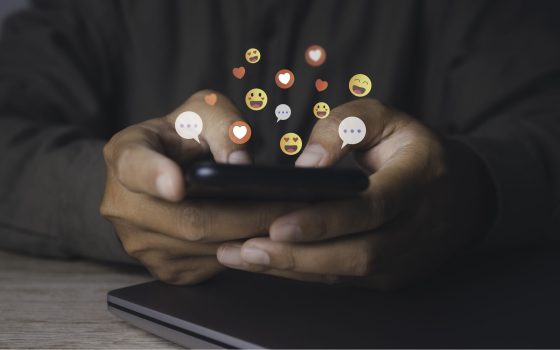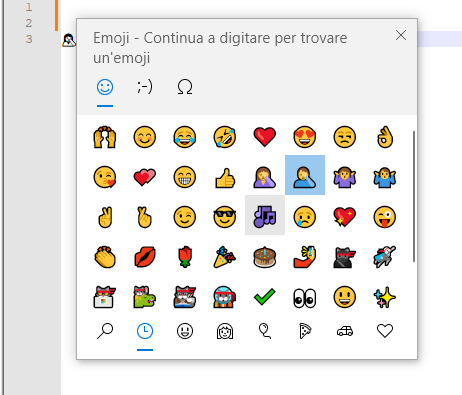In the past there were only the emoticon that is, representations useful for expressing emotions, moods or concepts in written texts. They are entered simply using the characters available on common keyboards: for example the symbol :-) (o :) in compact form) is the classic smiley face that expresses happiness and satisfaction. Emoticons are also mentioned in the Netiquette, which was finalized in 1995. Subsequently came the emoji that is, special graphic icons that live a life of their own, regardless of the symbols available on the keyboard. In another article we talked about the meaning of emojis and emoticons, highlighting the differences between one and the other.
Il termine emoji (which can be used indifferently in the feminine or masculine) derives from the combination of two Japanese words: “E” (絵) meaning “image” or “drawing” and “mine” (文字) which stands for “character” or “letter”. They are in fact small images or graphic symbols that represent emotions, objects, concepts text message and in digital communications.
L‘idea of emoji dates back to a Japanese telecommunications operator who introduced them in 1997. Apple was later persuaded to include emojis in its iPhones when they debuted in 2007 and then launched them internationally in 2011.
Emojis and intellectual property
Emojis derived from emoticons are generally not protected by the intellectual propertysince they are considered generic and functional elements to represent concepts or emotions.
Take for example WhatsApp and in the message entry field type ;-) (the winking face). Here, that emoticon – as well as all other standard emoticons – is automatically translated into the emoji corresponding.
The various software manufacturers are however usually developed a set Of custom emojis, even for those generated from the conversion of simple text emoticons. When using emojis, therefore, tread carefully because some of them may be protected by the copyright and usable only and exclusively within the platform for which they were designed.
Difference between types of emoji
Given that some emoji are “translated” starting from the most well-known emoticons, it must be said that there is a rich set of them made up of around 3,500 elements which is standardized by the Consortium Unicode, an organization that develops coding standards for the representation of texts and symbols on digital devices. This means that emoji are part of the Unicode standards and you can use them freely in accordance with the Unicode specifications. Simply visit the Unicode site to check which and how many emojis are directly supported.
In Windows try opening a text editor o one wordprocessor such as Word, LibreOffice, ONLYOFFICE, Google Docs, Word Online and so on. Then press the keys Windows+. (Windows key together with the dot): the operating system presents a series of emojis that can be inserted into the text. These emoji belong to the set created by Microsoft but each of them corresponds to a Unicode encoded icon.
Try selecting the emoji you just inserted, copy it (CTRL+C) then paste it into the Google search box by adding site:unicode.org. Among the results you will find the corresponding one Unicode code (for example 1F926). By selecting it, copying it, pasting it into Word or LibreOffice then pressing ALT+Xyou will get the corresponding emoji.
This confirms the close relationship between emoji and Unicode codes. We also explained it in the article where we see how to get special characters using the keyboard.
Even in the case of emojis that correspond to Unicode codes, however, many companies and developers create set custom emojis that may be subject to intellectual property rights. For example, Apple, Google, Microsoft and other companies have their own sets of emojis. The use of their emoji sets is generally regulated in the terms of service and conditions of use.
Some emojis may contain brand names o registered logos, such as explicit references to products or companies. Using such emojis in ways that violate trademark rights can lead to legal problems. Finally, some platforms allow users to create custom emojis or sticker. In this case, custom emoji may be subject to proprietary rights of the user or the company that created them.
The Openmoji project
OpenMoji is a project open source which focuses on creating a set of emoji accessible and free for general use. The project OpenMoji was therefore created with the aim of providing an open and zero-cost alternative to the proprietary emojis used on the various digital platforms.
The commitment is to create “free” graphic representations, inclusive and available to everyone, regardless of the platforms or devices used.
On the Openmoji website it is possible to carry out a search in order to identify the graphic support you are interested in at a glance: simply use the search box. Alternatively, the repository of GitHub allows you to download the entire archive currently available, which is continually expanding. The “anatomy” of OpenMoji folders is as follows:
black/ecolor/They contain all .png and .svg filesdata/Contains the fileopenmoji.jsonwith all the emoji metadata on filefont/Collect OpenMoji charactersguidelines/Hosts various template fileshelpers/Offers various support scripts, such as exporting to .png and .svg, generating hue variations, applying color palettes, etc.src/Contains all OpenMoji .svg source files. The files are divided into folders and files corresponding to Unicode groups and subgroupstest/Automated tests to ensure consistency across all .svg files
The license currently used for Openmoji allows any type of use, even for commercial projects, tolerating the application of modifications and the creation of derivative works. The important thing is to always include a note in your projects to indicate the origin of the graphic material. Furthermore, if derivative works are created starting from Openmoji it is mandatory to distribute them using the same license.
Opening image credit: iStock.com/1550539


